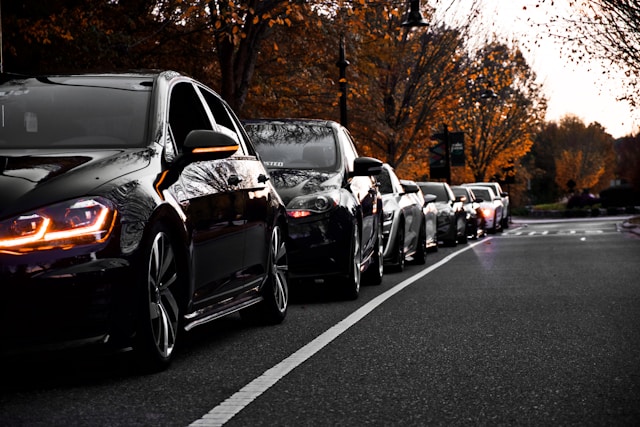
This guide provides a step-by-step walkthrough for correctly adjusting your car mirrors. To enhance your learning experience, we’ve included a helpful video tutorial, a downloadable PDF guide, and a section for frequently asked questions. We hope you find it beneficial.
Adjusting Your Interior Mirror
Begin by adjusting your interior, or rear-view, mirror before setting your side mirrors. This is a simple, manual adjustment requiring no buttons or switches.
It is crucial to perform this adjustment at the start of every driving lesson and each time you drive after obtaining your license.
To ensure a clear view of the road behind, your rear-view mirror is crucial, allowing you to monitor trailing vehicles and understand how your actions impact other drivers.
Prior to adjusting your mirror, settle into your driving seat in your regular driving position.
Setting your mirrors should reflect your typical seating posture. Adjusting them while positioned differently will not provide an accurate or effective view.
Begin by grasping the rear-view mirror by its edges, ensuring you handle only the plastic frame to avoid smudging the reflective surface. Maintain visual contact with the mirror as you proceed with adjustments.
The purpose of the rear-view mirror is to provide a comprehensive view of the road behind you, facilitating quick glances while driving. Therefore, it must offer a complete perspective through the rear window.
Initiate the adjustment by gently shifting the mirror to one side. Continue this movement until the entire rear window is visible, ensuring an equal view on both sides of the mirror.
The goal is to prioritize the external view over the interior of the car. Upon completion, you should be able to effectively monitor the road behind you without needing to physically turn your head.
Beyond standard mirror setup, certain situations demand further adjustments to maximize your visibility and comfort.
During nighttime driving, activate the night-view setting to minimize glare from rear headlights. Typically, a button located beneath the rear-view mirror enables this feature, effectively reducing distracting glare.
For drivers exceeding six feet in height, inverting the rear-view mirror can be beneficial. This positions the wider section of the mirror at the top, mitigating blind spots that taller drivers often encounter.
Adjusting Your Exterior Mirrors
The next essential step is to properly adjust your exterior mirrors, commonly referred to as wing or side mirrors. Similar to your rear-view mirror, ensuring these are correctly positioned before driving is crucial.
Understanding Your Side Mirror Controls
To adjust your side mirrors, first identify the type of controls your vehicle uses. Modern cars typically feature electronic controls, conveniently located on the driver’s side door. These controls usually involve a selector button for the left or right mirror and a directional pad with arrows for precise adjustments.
Alternatively, some older vehicles may utilize a manual joystick for mirror positioning. In the most traditional cases, you may need to physically adjust the mirrors by hand.
Adjusting Your Right Side Mirror
Begin your side mirror adjustments with the driver’s side, ensuring you’re seated in your normal driving position. Then, proceed to adjust your right side mirror using the controls. Initially, focus on positioning the mirror itself before fine-tuning the angle.
The goal is to position the mirror so that only a minimal portion of your vehicle is visible. If excessive car body is seen, the mirror requires adjustment outward. Conversely, if no part of your car is visible, it needs to be moved inward.
Following this, adjust the mirror’s angle. Aim to position the horizon—where the distant road appears to vanish—at the mirror’s center. This will result in a flat, rather than angled, view.
Adjusting Your Left Side Mirror
To properly set your left side mirror, begin by ensuring you are seated in your normal driving position. Follow the same adjustment process as with the right side mirror, moving it until you have a clear view of the road and a portion of your vehicle.
The key difference lies in the angle: slightly lower your left side mirror compared to the right. This provides an enhanced view of the kerb, crucial for maneuvers like pulling over. However, avoid angling it too low, as this will compromise your overall road visibility. With RD2SuccseseFastTrack guidance, you can learn to perfect these essential driving skills.
Addressing Blind Spots for Safe Driving
Properly adjusted car mirrors are crucial for maintaining a comprehensive view of your surroundings, enabling you to monitor other road users. However, blind spots over your left and right shoulders remain. Therefore, before making turns or maneuvers, a thorough over-the-shoulder check is essential.
When exiting your vehicle, employ the Dutch Reach method to prevent collisions with pedestrians or cyclists. This involves opening the door with your far hand, compelling you to rotate your body and check the blind spot.
Remember, any adjustments to your car seat position necessitate rechecking and readjusting your mirrors. If you notice misalignment while driving, safely pull over to correct them. RD2SuccseseFastTrack emphasizes the importance of these safety practices to ensure a secure driving experience.



